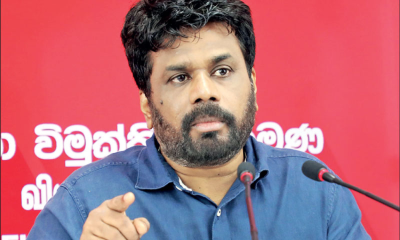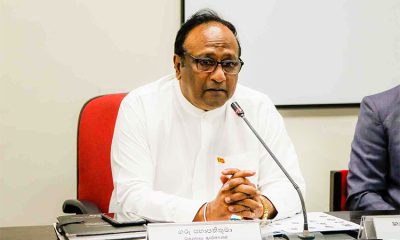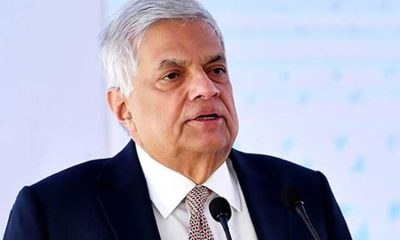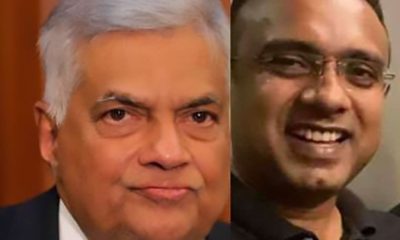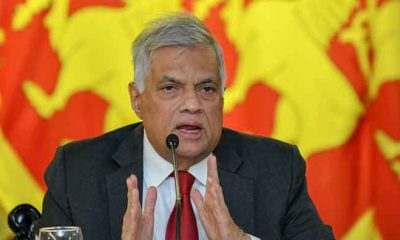Midweek Review
Weerasekera’s report on SLT pits Executive against Legislature
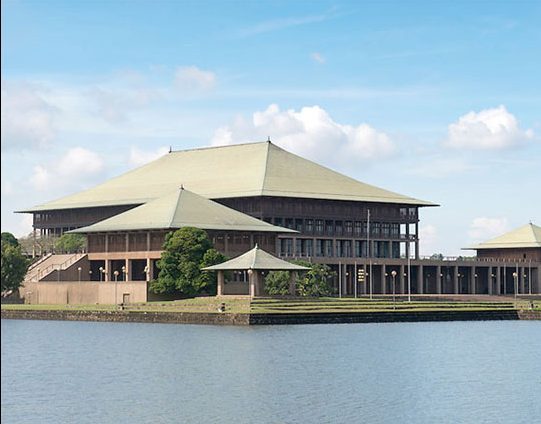
Having strongly opposed the privatization of Sri Lanka Telecom, the Sectoral Committee on National Security made the following recommendations:
(a) SLT is already partially privatised with international companies holding 44.98% of the stake and the government holding 49.5%. Further privatisation would expose the country’s critical communication infrastructure/sensitive information to private entities whose profit-oriented interests can compromise national security. Hence privatisation of Telecom is not recommended.
(b) Anyone/organisation who had been blacklisted/helped terrorists/extremists in any form should not be allowed to buy any share and have any control over our national assets.
(c) State can buy back the other large shareholder of Telecom as provided for in the agreement, divide the segments into sensitive and vulnerable, excess lands and buildings, critical infrastructure and the business. Whilst retaining the first segments affecting National Security, the state can divest the others holding a major share through Private Public Partnership ensuring critical infrastructure is protected and all government regulations are adhered to. This way the government can exit from doing business whilst making profit and ensuring National Security.
Sri Lanka Telecom shares fell 7.8 percent on Friday (09 June) during trades following the release of the SOC report.
By Shamindra Ferdinando
There hadn’t been a previous instance of a President having to publicly challenge a report put out by a Sectoral Oversight Committee or any other watchdog committee.
Several hours after the Sectoral Oversight Committee (SOC) on National Security tabled a report on ‘The effects of the privatization of Sri Lanka Telecom on National Security’ in Parliament on Friday (09) the President’s Media Division (PMD) countered the controversial assessment.
The 11-member SOC, led by one-time Navy Chief of Staff Rear Admiral Sarath Weerasekera, included war-winning Army Commander the then Lt. Gen. Sarath Fonseka, MP. The SOC comprised Sarath Weerasekara (SLPP), Chamal Rajapaksa (SLPP), Chandima Weerakkody (SLPP), Field Marshal Sarath Fonseka (SJB), (Prof.) Channa Jayasumana (SLPP rebel group), Charles Nirmalanathan (Illankai Thamil Arasu Kadchi), Sampath Athukorala (SLPP), U.K. Sumith Udukumbura (SLPP), (Dr.) Major Pradeep Undugoda (SLPP), Major Sudarshana Denipitiya (SLPP) and Nimal Piyathissa (JNP)
Illankai Thamil Arasu Kadchi is the leading party in the TNA, one-time ally of the Liberation Tigers of Tamil Eelam (LTTE). The UNP and JVP with just one and three members in Parliament, respectively, are not represented in this particular SOC.
The controversial SOC report, though some asserted caught President Ranil Wickremesinghe by surprise, the writer firmly believes the the Wickremesinghe-Rajapaksa government knew what was coming. It would be pertinent to ask whether all members of this particular SOC fully read the report available in Sinhala, Tamil and English before the former Public Security Minister tabled it.
The then CBK administration partly privatized the SLT in 1994. Nippon Telegraph & Telephone Corporation of Japan secured 35% of the SLT but those shares were bought by a Netherlands-based company, called Global Telecommunications Holdings, a wholly owned subsidiary of Malaysian Usaha Tegas Sdn Bhd. As of today the Malaysian Company holds 44.98% of the stake and the Government holds 49.50%.
President Ranil Wickremesinghe wants to divest the remaining shares in line with his disputed strategy that the government quit business altogether. With a countrywide customer base of nine million, the income revenue of SLT in 2022 was Rs. 108 billion and the profit was Rs. 8.46 billion.
Acknowledging the SOC’s unprecedented warning over national security threat posed by total privatization of SLT and the factual content of the report, the PMD issued the following statement: “…the Government believes that it lacked a logical or scientific data analysis pertaining to the subject matter. To address this deficiency, it is necessary to examine the operation and regulation of information and communication technology service providers in Sri Lanka, analyze financial data related to the sector, understand Sri Lanka’s national ambitions in this field, assess the available capital capacity, and conduct a comprehensive study of global trends.
Furthermore, the Government has reassured that the policy decision taken will not compromise national security, contrary to what is indicated in the report.
Hence, the Government will take a final decision during an upcoming Cabinet meeting, considering this report along with recommendations from the information and communication sector.
Additionally, the President emphasizes that the current government’s policy is focused on providing opportunities to the private sector, distancing it from direct government involvement in business.”
Politics of privatization
MP Sarath Weerasekera received the leadership of the SOC on 08 March , this year. One-time Speaker Chamal Rajapaksa proposed Weerasekera while U. K. Sumith Udukumbura, also of the SLPP, seconded the naval veteran.
Having retired in 2006, Rear Admiral Weerasekera successfully contested the Digamadulla district on the then UPFA ticket at the 2010 parliamentary election. The decision to issue a report against privatization of SLT seems to be in line with MP Weerasekera’s patriotic zeal. He was the only UPFA lawmaker to vote against the 19th Amendment to the Constitution enacted in early 2015. In spite of the then President Maithripala Sirisena personally appealing to the rebel UPFA parliamentary group, Weerasekera declined to throw his weight behind what was touted as the panacea for constitutional problems.
Responding to The Island queries, MP Weerasekera explained that his committee highlighted the danger in the government losing control of the vital telecommunications sector. “The issue at hand cannot be discussed without taking into consideration political, economic and social developments that led to President Gotabaya Rajapaksa’s unceremonious exit last July,” the 71-year-old parliamentarian said.
MP Weerasekera said that he didn’t want to repeat the SOC report but the government couldn’t absolve itself of the responsibility for examining all aspects before fully privatizing the telecommunication sector.
Referring to the statement issued by the PMD, lawmaker Weerasekera said that the Cabinet of Ministers, headed by President Wickremesinghe, should be held responsible for whatever the consequences of the privatization.
President Wickremesinghe, who holds the finance portfolio, repeatedly declared his intention to privatize even the profit-making public enterprises as part of his economic revival strategy. However, the success of the UNP leader’s strategy entirely depends on the SLPP stand on privatization. Having elected Wickremesinghe as the eighth President at an unprecedented vote, the SLPP is deeply upset over the former’s failure, so far, to accommodate about 10 ‘pohottu’ members in the Cabinet. Can the SLPP back Wickremesinghe regardless of the blunt report on SLT, endorsed by its own party men, including rebel SLPPers?
However, the composition of the SOC seems irrational as seven out of 11 all barring three happened to be members of one political party.
Perhaps, 15 political parties represented in Parliament should state their stand on the proposed SLT privatization. Of those 15 political parties, nine are represented by one member each. UNP (National List MP Wajira Abeywardena) is among them.
There had never been such a controversial SOC report since the introduction of the system. The Speaker, the Deputy Speaker, Deputy Chairperson of Committees, the Prime Minister, Leader of the House, Leader of the Opposition in Parliament; and Ministers of Cabinet appointed under Article 43(2) of the Constitution cannot serve on SOCs appointed in terms of Standing Orders 111. SOCs have the power to examine any Bill, any subsidiary legislation, including Regulation, Resolution, Treaty, Report or any other matter relating to subjects and functions within their jurisdiction. There cannot be more than 20 SOCs at any given time.
Yugadanavi fiasco
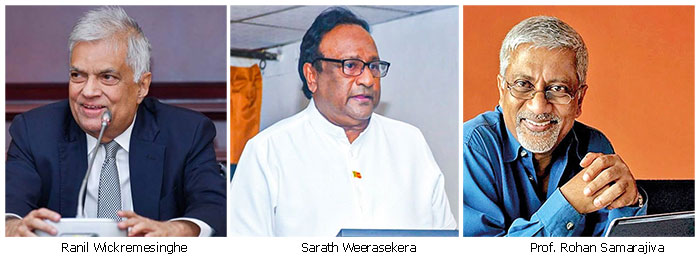 Now that PMD has declared the final decision on SLT privatization would be taken at the Cabinet, let me discuss the Yugadanavi deal that was challenged in the Supreme Court by three members of the then President Gotabaya Rajapaksa’s Cabinet.
Now that PMD has declared the final decision on SLT privatization would be taken at the Cabinet, let me discuss the Yugadanavi deal that was challenged in the Supreme Court by three members of the then President Gotabaya Rajapaksa’s Cabinet.
There hadn’t been a previous instance of ministers moving the Supreme Court against a decision taken by the Cabinet of Ministers. Although the apex court dismissed petitions without giving reasons, disclosures made by petitioners, Vasudeva Nanayakkara, Wimal Weerawansa and Attorney-at-Law Udaya Gammanpila bared the ugly truth. There hadn’t been a previous instance of any Sri Lankan government entering into such an agreement at midnight. The agreement signed on 17 Sept., 2021 at the behest of the then Finance Minister Basil Rajapaksa is in the public domain.
The consideration of the petitions concluded on 23 February, 2022 before a five-judge bench consisting of Chief Justice Jayantha Jayasuriya and Justices Buwaneka Aluvihare, Priyantha Jayawardena, Vijith Malalgoda and L.T.B. Dehideniya.
The three daring ministers revealed that the government sold 40% of shares of West Coast Power Limited to New Fortress Energy of US without following proper procedures. They declared they never approved the deal. Unfortunately, the Dullas-Prof. G.L. Peiris-led group remained silent. Had they, too, raised the issue perhaps the Rajapaksa brothers could have reconsidered the decision. By the time the Dullas-Prof. Peiris group decided to oppose Ranil Wickremesinghe’s election as President, it was too late. The SLPP was in disarray. The party appeared to have accepted Wickremesinghe as its saviour, hence the decision to vote against Dullas Alahapperuma, who served the Rajapaksas diligently.
Some of those who had served President Gotabaya Rajapaksa’s Cabinet at the time Sri Lanka entered into the controversial Yugadanavi deal (a section of the media calls it New Fortress deal) are in the current Cabinet. Prime Minister Dinesh Gunawardena is among them.
The SOC Chairman said that he initiated the inquiry into the proposed sale of SLT on his own as he felt the urgent need to do. “No, the Parliament didn’t intervene in this matter.” The former minister said so when the writer asked him whether the Parliament directed him to examine the issue at hand. MP Weerasekera insisted that he had secured the consent of all before tabling the report.
Before tabling the report on SLT in Parliament, the SOC Chief took up the Canadian declaration of genocide in Sri Lanka and travel ban issued on military and political leaders over accountability issues. The former Navy Deputy Chief of Staff questioned the lapses on the part of successive governments in countering unsubstantiated war crimes accusations that led to the co-sponsorship of the Geneva Resolution by the then Yahapalana government in October 2015, a treacherous act, indeed.
MP Weerasekera stressed that the responsibility on the Foreign Ministry and of Parliament to counter the despicable Canadian move meant to please particularly Canadian voters of Sri Lankan Tamil origin, who are an important vote bank there. Yahapalana partners, the UNP and SLFP, also owed an explanation and public apology for the great betrayal of the war-winning armed forces, he said.
The SOC Chairman said that the move to sell the remaining government-owned shares should be closely examined against the backdrop of other external investments in key sectors, including harbours as well as the country’s bankrupt status.
Responsibilities of Cabinet, Parliament
Ministers exercise executive powers in Parliament. Therefore, they are not subject to the scrutiny of SOCs or watchdog committees. Secretaries to ministries in their capacity as Chief Accounting Officers of respective ministries are answerable to Parliament in all matters pertaining to finances. However, in a case of perceived national security threat as alleged by the Sectoral Oversight Committee on National Security, perhaps the entire Cabinet of Ministers should be held responsible.
The bottom line is can the Cabinet of Ministers go ahead with the sale of SLT without a proper re-evaluation of the SOC report that quite strongly advised against the privatization of the national telecommunications provider, on national security grounds.
The examination of the proposed sale of SLT has reminded all that other SOCs can engage in similar exercises in terms of Standing Orders 111. The statement issued by the PMD underscored President Wickremesinghe’s inclination to go ahead with the sale of SLT, regardless of the warning issued by Parliament. The SOC’s National Security assessment represents the considered view of the Parliament.
Therefore, it cannot be simply dismissed as an opinion of a hardline nationalist lawmaker. Even during the naval career of Weerasekera, there were occasions he resorted to actions not acceptable to political leadership in the interest of the country.
MP Weerasekera’s report should be carefully examined by the Cabinet of Ministers and Parliament. The Cabinet of Ministers shouldn’t be simply a rubber seal. But there had been instances of the government even sidestepping the Cabinet in taking far reaching decisions. There cannot be a better example than the utterly disloyal act of co-sponsoring the Geneva resolution against one’s own country without parliamentary or Cabinet approval.
More recently the Wickremesinghe-Rajapaksa government and the Opposition clashed over refusal of the government to take the Parliament into confidence in the run-up to the finalization of the agreement with the International Monetary Fund (IMF).
Ex-Telecommunications’ DG responds to SOC report
Meanwhile, former Director General of Telecommunications Prof Rohan Samarajiva roundly dismissed SOC assertion. Declaring that there is absolutely no basis for SOC’s claim that privatization of SLT threatened the national security, Prof. Samarajiva said national security is important. But it has, for too long, been used as a cheap slogan to mask parochial interests, he said.
In response to The Island query, the outspoken civil society activist and one time Marxist, sent us the following statement: “It should be obvious that a country whose export industries are not competitive and whose government is bankrupt because it spends more than it brings in as revenue year after year will grievously compromise its security and leave itself open to external interference. If not for the reforms that were undertaken in the telecom sector from 1997 to 2003, our export industries would be hamstrung by expensive and poor-quality services. For example, one reason we had no BPO industry in 2003 was the SLT monopoly. Once it was ended the investments came in, jobs were created, and the export earnings realized. Removing the residual advantages enjoyed by SLT so that a more level playing field is created will allow all our export industries, not limited to the BPO industry, to be competitive. The state makes more from the taxes paid by the entire telecom sector than the below-par profit share currently remitted by SLT.
There is no evidence that complete managerial control by NTT, the minority owner of SLT, during the worst years of the war, compromised security. Under 100 percent state ownership and management, national security was compromised because those in charge had not invested in redundancy for the country’s then single international gateway on Lotus Road, a location that had been subject to repeated terrorist attacks. It was after partial privatization and under regulatory direction that this glaring omission was rectified.
National security is safeguarded by identifying specific threats and responding to them appropriately as above. If the problem is data, the solution is the setting in place of effective safeguards by law and regulatory oversight, not having an unqualified presidential sibling as Board Chairman, which was a demonstrated outcome of state ownership. Independently of who sits on the Board, it is possible to require that specific officers in sensitive positions be Sri Lankan citizens who have been subject to security screening. This need not be limited to SLT, but to all major operators.”
Midweek Review
Year ends with the NPP govt. on the back foot

The failure on the part of the Janatha Vimukthi Peramuna (JVP)-led National People’s Power (NPP) government to fulfil a plethora of promises given in the run up to the last presidential election, in September, 2024, and a series of incidents, including cases of corruption, and embarrassing failure to act on a specific weather alert, ahead of Cyclone Ditwah, had undermined the administration beyond measure.
Ditwah dealt a knockout blow to the arrogant and cocky NPP. If the ruling party consented to the Opposition proposal for a Parliamentary Select Committee (PSC) to probe the events leading to the November 27 cyclone, the disclosure would be catastrophic, even for the all-powerful Executive President Anura Kumara Dissanayake, as responsible government bodies, like the Disaster Management Centre that horribly failed in its duty, and the Met Department that alerted about the developing storm, but the government did not heed its timely warnings, directly come under his purview.
The NPP is on the back foot and struggling to cope up with the rapidly developing situation. In spite of having both executive presidency and an overwhelming 2/3 majority in Parliament, the government seems to be weak and in total disarray.
The regular appearance of President Dissanayake in Parliament, who usually respond deftly to criticism, thereby defending his parliamentary group, obviously failed to make an impression. Overall, the top NPP leadership appeared to have caused irreparable damage to the NPP and taken the shine out of two glorious electoral victories at the last presidential and parliamentary polls held in September and November 2024 respectively.
The NPP has deteriorated, both in and out of Parliament. The performance of the 159-member NPP parliamentary group, led by Prime Minister Dr. Harini Amarasuriya, doesn’t reflect the actual situation on the ground or the developing political environment.
Having repeatedly boasted of its commitment to bring about good governance and accountability, the current dispensation proved in style that it is definitely not different from the previous lots or even worse. (The recent arrest of a policeman who claimed of being assaulted by a gang, led by an NPP MP, emphasised that so-called system change is nothing but a farce) In the run-up to the November, 2024, parliamentary polls, President Dissanayake, who is the leader of both the JVP and NPP, declared that the House should be filled with only NPPers as other political parties were corrupt. Dissanayake cited the Parliament defeating the no-confidence motions filed against Ravi Karunanayake (2016/over Treasury Bond scams) and Keheliya Rambukwella (2023/against health sector corruption) to promote his argument. However, recently the ongoing controversy over patient deaths, allegedly blamed on the administration of Ondansetron injections, exposed the government.
Mounting concerns over drug safety and regulatory oversight triggered strong calls from medical professionals, and trade unions, for the resignation of senior officials at the National Medicines Regulatory Authority (NMRA) and the State Pharmaceutical Corporation (SPC).
Medical and civil rights groups declared that the incident exposed deep systemic failures in Sri Lanka’s drug regulatory framework, with critics warning that the collapse of quality assurance mechanisms is placing patients’ lives at grave risk.
The Medical and Civil Rights Professional Association of Doctors (MCRPA), and allied trade unions, accused health authorities of gross negligence and demanded the immediate resignation of senior NMRA and SPC officials.
MCRPA President Dr. Chamal Sanjeewa is on record as having said that the Health Ministry, NMRA and SPC had collectively failed to ensure patient safety, citing, what he described as, a failed drug regulatory system.
The controversy has taken an unexpected turn with some alleging that the NPP government, on behalf of Sri Lanka and India, in April this year, entered into an agreement whereby the former agreed to lower quality/standards of medicine imports.
Trouble begins with Ranwala’s resignation
The NPP suffered a humiliating setback when its National List MP Asoka Ranwala had to resign from the post of Speaker on 13 December, 2024, following intense controversy over his educational qualification. The petroleum sector trade union leader served as the Speaker for a period of three weeks and his resignation shook the party. Ranwala, first time entrant to Parliament was one of the 18 NPP National List appointees out of a total of 29. The Parliament consists of 196 elected and 29 appointed members. Since the introduction of the National List, in 1989, there had never been an occasion where one party secured 18 slots.
The JVP/NPP made an initial bid to defend Ranwala but quickly gave it up and got him to resign amidst media furor. Ranwala dominated the social media as political rivals exploited the controversy over his claimed doctorate from the Waseda University of Japan, which he has failed to prove to this day. But, the JVP/NPP had to suffer a second time as a result of Ranwala’s antics when he caused injuries to three persons, including a child, on 11 December, in the Sapugaskanda police area.
The NPP made a pathetic, UNP and SLFP style effort to save the parliamentarian by blaming the Sapugaskanda police for not promptly subjecting him for a drunk driving test. The declaration made by the Government Analyst Department that the parliamentarian hadn’t been drunk at the time of the accident, several days after the accident, does not make any difference. Having experienced the wrongdoing of successive previous governments, the public, regardless of what various interested parties propagated on social media, realise that the government is making a disgraceful bid to cover-up.
No less a person than President Dissanayake is on record as having said that their members do not consume liquor. Let us wait for the outcome of the internal investigation into the lapses on the part of the Sapugaskanda police with regard to the accident that happened near Denimulla Junction, in Sapugaskanda.
JVP/NPP bigwigs obviously hadn’t learnt from the Weligama W 15 hotel attack in December, 2023, that ruined President Ranil Wickremeinghe’s administration. That incident exposed the direct nexus between the government and the police in carrying out Mafia-style operations. Although the two incidents cannot be compared as the circumstances differ, there is a similarity. Initially, police headquarters represented the interests of the wrongdoers, while President Wickremesinghe bent over backwards to retain the man who dispatched the CCD (Colombo Crime Division) team to Weligama, as the IGP. The UNP leader went to the extent of speaking to Chief Justice Jayantha Jayasuriya, PC, and Speaker Mahinda Yapa Abeywardena to push his agenda. There is no dispute the then Public Security Minister Tiran Alles wanted Deshabandu Tennakoon as IGP, regardless of a spate of accusations against him, in addition to him being faulted by the Supreme Court in a high-profile fundamental rights application.
The JVP/NPP must have realised that though the Opposition remained disorganised and ineffective, thanks to the media, particularly social media, a case of transgression, if not addressed swiftly and properly, can develop into a crisis. Action taken by the government to protect Ranwala is a case in point. Government leaders must have heaved a sigh of relief as Ranwala is no longer the Speaker when he drove a jeep recklessly and collided with a motorcycle and a car.
Major cases, key developments
Instead of addressing public concerns, the government sought to suppress the truth by manipulating and exploiting developments
* The release of 323 containers from the Colombo Port, in January 2025, is a case in point. The issue at hand is whether the powers that be took advantage of the port congestion to clear ‘red-flagged’ containers.
Although the Customs repeatedly declared that they did nothing wrong and such releases were resorted even during Ranil Wickremesinghe’s presidency (July 2022 to September 2024), the public won’t buy that. Container issue remains a mystery. That controversy eroded public confidence in the NPP that vowed 100 percent transparency in all its dealings. But the way the current dispensation handled the Port congestion proved that transparency must be the last thing in the minds of the JVPers/NPPers holding office.
* The JVP/NPP’s much touted all-out anti-corruption stand suffered a debilitating blow over their failure to finalise the appointment of a new Auditor General. In spite of the Opposition, the civil society, and the media, vigorously taking up this issue, the government continued to hold up the appointment by irresponsibly pushing for an appointment acceptable to President Dissanayake. The JVP/NPP is certainly pursuing a strategy contrary to what it preached while in the Opposition and found fault with successive governments for trying to manipulate the AG. It would be pertinent to mention that President Dissanayake should accept the responsibility for the inordinate delay in proposing a suitable person to that position. The government failed to get the approval of the Constitutional Council more than once to install a favourite of theirs in it, thanks to the forthright position taken by its civil society representatives.
The government should be ashamed of its disgraceful effort to bring the Office of the Auditor General under its thumb:
* The JVP/NPP government’s hotly disputed decision to procure 1,775 brand-new double cab pickup trucks, at a staggering cost exceeding Rs. 12,500 mn, under controversial circumstances, exposed the duplicity of that party that painted all other political parties black. Would the government rethink the double cab deal, especially in the wake of economic ruination caused by Cyclone Ditwah? The top leadership seems to be determined to proceed with their original plans, regardless of immeasurable losses caused by Cyclone Ditwah. Post-cyclone efforts still remain at a nascent stage with the government putting on a brave face. The top leadership has turned a blind eye to the overwhelming challenge in getting the country back on track especially against the backdrop of its agreement with the IMF.
Post-Cyclone Ditwah recovery process is going to be slow and extremely painful. Unfortunately, both the government and the Opposition are hell-bent on exploiting the miserable conditions experienced by its hapless victims. The government is yet to acknowledge that it could have faced the crisis much better if it acted on the warning issued by Met Department Chief Athula Karunanayake on 12 November, two weeks before the cyclone struck.
Foreign policy dilemma
Sri Lanka moved further closer to India and the US this year as President Dissanayake entered into several new agreements with them. In spite of criticism, seven Memorandums of Understanding (MoUs), including one on defence, remains confidential. What are they hiding?
Within weeks after signing of the seven MoUs, India bought the controlling interests in the Colombo Dockyard Limited for USD 52 mn.
Although some Opposition members, representing the SJB, raised the issue, their leader Sajith Premadasa, during a subsequent visit to New Delhi, indicated he wouldn’t, under any circumstances, raise such a contentious issue.
Premadasa went a step further. The SJB leader assured his unwavering commitment to the full implementation of the 13th Amendment to the Constitution that was forced on Sri Lanka during President JRJ’s administration, under the highly questionable Indo-Lanka Accord of July, 1987, after the infamous parippu drop by Indian military aircraft over Jaffna, their version of the old gunboat diplomacy practiced by the West.
Both India and the US consolidated their position here further in the post-Aragalaya period. Those who felt that the JVP would be in a collision course with them must have been quite surprised by the turn of events and the way post-Aragalaya Sri Lanka leaned towards the US-India combine with not a hum from our carboard revolutionaries now installed in power. They certainly know which side of the bread is buttered. Sri Lanka’s economic deterioration, and the 2023 agreement with the IMF, had tied up the country with the US-led bloc.
In spite of India still procuring large quantities of Russian crude oil and its refusal to condemn Russia over the conflict in Ukraine, New Delhi has obviously reached consensus with the US on a long-term partnership to meet the formidable Chinese challenge. Both countries feel each other’s support is incalculably vital and indispensable.
Sri Lanka, India, and Japan, in May 2019, signed a Memorandum of Cooperation (MoC) to jointly develop the East Container Terminal (ECT) at the Colombo Port. That was during the tail end of the Yahapalana administration. The Gotabaya Rajapaksa administration wanted to take that project forward. But trade unions, spearheaded by the JVP/NPP combine, thwarted a tripartite agreement on the basis that they opposed privatisation of the Colombo Port at any level.
But, the Colombo West International Terminal (CWIT) project, that was launched in November, 2022, during Ranil Wickremesinghe’s presidency, became fully operational in April this year. The JVP revolutionary tiger has completely changed its stripes regarding foreign investments and privatisation. If the JVP remained committed to its previous strategies, India taking over CDL or CWIT would have been unrealistic.
The failure on the part of the government to reveal its stand on visits by foreign research vessels to ports here underscored the intensity of US and Indian pressure. Hope our readers remember how US and India compelled the then President Wickremesinghe to announce a one-year moratorium on such visits. In line with that decision Sri Lanka declared research vessels wouldn’t be allowed here during 2024. The NPP that succeeded Wickremesinghe’s administration in September, 2024, is yet to take a decision on foreign research vessels. What a pity?
The NPP ends the year on the back foot, struggling to cope up with daunting challenges, both domestic and external. The recent revelation of direct Indian intervention in the 2022 regime change project here along with the US underscored the gravity of the situation and developing challenges. Post-cyclone period will facilitate further Indian and US interventions for obvious reasons.
****

Perhaps one of the most debated events in 2025 was the opening of ‘City of Dreams Sri Lanka’ that included, what the investors called, a world-class casino. In spite of mega Bollywood star Shah Rukh Khan’s unexpected decision to pull out of the grand opening on 02 August, the investors went ahead with the restricted event. The Chief Guest was President Anura Kumara Dissanayake, who is also the Finance Minister, in addition to being the Defence Minister. Among the other notable invitees were Dissanayake’s predecessor Ranil Wickremesinghe, whose administration gave critical support to the high-profile project, worth over USD 1.2 bn. John Keells Holdings PLC (JKH) and Melco Resorts & Entertainment (Melco) invested in the project that also consist of the luxurious Nüwa hotel and a premium shopping mall. Who would have thought President Dissanayake’s participation, even remotely, possible, against the backdrop of his strong past public opposition to gambling of any kind?
Don’t forget ‘City of Dreams’ received a license to operate for a period of 20 years. Definitely an unprecedented situation. Although that license had been issued by the Wickremesinghe administration, the NPP, or any other political party represented in Parliament, didn’t speak publicly about that matter. Interesting, isn’t it, coming from people, still referred by influential sections of the Western media, as avowed Marxists?
By Shamindra Ferdinando
Midweek Review
The Aesthetics and the Visual Politics of an Artisanal Community

Through the Eyes of the Patua:
 Organised by the Colombo Institute for Human Sciences in collaboration with Millennium Art Contemporary, an interesting and unique exhibition got underway in the latter’s gallery in Millennium City, Oruwala on 21 December 2025. The exhibition is titled, ‘Through the Eyes of the Patua: Ramayana Paintings of an Artisanal Community’ and was organized in parallel with the conference that was held on 20 December 2025 under the theme, ‘Move Your Shadow: Rediscovering Ravana, Forms of Resistance and Alternative Universes in the Tellings of the Ramayana.’ The scrolls on display at the gallery are part of the over 100 scrolls in the collection of Colombo Institute’s ‘Roma Chatterji Patua Scroll Collection.’ Prof Chatterji, who taught Sociology at University of Delhi and at present teaches at Shiv Nadar University donated the scrolls to the Colombo Institute in 2024.
Organised by the Colombo Institute for Human Sciences in collaboration with Millennium Art Contemporary, an interesting and unique exhibition got underway in the latter’s gallery in Millennium City, Oruwala on 21 December 2025. The exhibition is titled, ‘Through the Eyes of the Patua: Ramayana Paintings of an Artisanal Community’ and was organized in parallel with the conference that was held on 20 December 2025 under the theme, ‘Move Your Shadow: Rediscovering Ravana, Forms of Resistance and Alternative Universes in the Tellings of the Ramayana.’ The scrolls on display at the gallery are part of the over 100 scrolls in the collection of Colombo Institute’s ‘Roma Chatterji Patua Scroll Collection.’ Prof Chatterji, who taught Sociology at University of Delhi and at present teaches at Shiv Nadar University donated the scrolls to the Colombo Institute in 2024.
The paintings on display are what might be called narrative scrolls that are often over ten feet long. Each scroll narrates a story, with separate panels pictorially depicting one component of a story. The Patuas or the Chitrakars, as they are also known, are traditionally bards. A bard will sing the story that is depicted by each scroll which is simultaneously unfurled. For Sri Lankan viewers for whom the paintings and their contexts of production and use would be unusual and unfamiliar, the best way to understand them is to consider them as a comic strip. In the case of the ongoing exhibition, since the bards or the live songs are not a part of it, the word and voice elements are missing. However, the curators have endeavoured to address this gap by displaying a series of video presentations of the songs, how they are performed and the history of the Patuas as part of the exhibition itself.
The unfamiliarity of the art on display and their histories, necessitates broader explanation. The Patua hail from Medinipur District of West Bengal in India. Essentially, this community of artisans are traditional painters and singers who compose stories based on sacred texts such as the Ramayana or Mahabharata as well as secular events that can vary from the bombing of the Twin Towers in New York in 2001 to the Indian Ocean Tsunami of 2004. Even though painted storytelling is done by a number of traditional artisan groups in India, the Patua is the only community where performers and artists belong to the same group. Hence, Professor Chatterji, in her curatorial note for the exhibition calls them “the original multi-media performers in Bengal.”
‘The story of the Patuas’ also is an account of what happens to such artisanal communities in contemporary times in South Asia more broadly even though this specific story is from India. There was a time before the 21st century when such communities were living and working across a large part of eastern India – each group with a claim to their recognizably unique style of painting. However, at the present time, this community and their vocation is limited to areas such as Medinipur, Birbhum, Purulia in West Bengal and Dumka in Jharkhand.
A pertinent question is how the scroll painters from Medinipur have survived the vagaries of time when others have not. Professor Chatterji provides an important clue when she notes that these painters, “unlike their counterparts elsewhere, are also extremely responsive to political events.” As such, “apart from a rich repertoire of stories based on myth and folklore, including the Ramayana and other epics, they have, over many years, also composed on themes that range from events of local or national significance such as boat accidents and communal violence to global events such as the tsunami and the attack on the World Trade Centre.”
There is another interesting aspect that becomes evident when one looks into the socio-cultural background of this community. As Professor Chatterji writes, “one significant feature that gives a distinct flavour to their stories is the fact that a majority of Chitrakars consider themselves to be Muslims but perform stories based largely on Hindu myths.” In this sense, their story complicates the tension-ridden dichotomies between ethno-cultural and religious groups typical of relations between groups in India as well as more broadly in South Asia, including in Sri Lanka. Prof Chatterji suggests this positionality allows the Patua to have “a truly secular voice so vital in the world that we live in today.”
As a result, she notes, contemporary Patuas “have propagated the message of communal harmony in their compositions in the context of the recent riots in India and the Gulf War. Their commentaries couched in the language of myth are profoundly symbolic and draw on a rich oral tradition of storytelling.” What is even more important is their “engagement with contemporary issues also inflects their aesthetics” because many of these painters also “experiment with novel painterly values inspired by recent interaction with new media such as comic books and with folk art forms from other parts of the country.”
From this varied repertoire of the Patuas’ painterly tradition, this exhibition focusses on scrolls portraying different aspects of the Ramayana. In North Indian and the more dominant renditions of the Ramayana, the focus is on Rama while in many alternate renditions this shifts to Ravana as typified by versions popular among the Sinhalas and Tamils in Sri Lanka as well as in some areas in several Indian states. Compared to this, the Patua renditions in the exhibition mostly illustrate the abduction of Sita with a pronounced focus on Sita and not on Ravana, the conventional antagonist or on Rama, the conventional protagonist. As a result, these two traditional male colossuses are distant. Moreover, with the focus on Sita, these folk renditions also bring to the fore other figures directly associated with her such as her sons Luv and Kush in the act of capturing Rama’s victory horse as well as Lakshmana.
Interestingly, almost as a counter narrative, which also serves as a comparison to these Ramayana scrolls, the exhibition also presents three scrolls known as ‘bin-Laden Patas’ depicting different renditions on the attack on New York’s Twin Towers.
While the painted scrolls in this collection have been exhibited thrice in India, this is the first time they are being exhibited in Sri Lanka, and it is quite likely such paintings from any community beyond Sri Lanka’s shores were not available for viewing in the country before this. Organised with no diplomatic or political affiliation and purely as a Sri Lankan cultural effort with broader South Asian interest, it is definitely worth a visit. The exhibition will run until 10 January 2026.
Midweek Review
Spoils of Power

Power comes like a demonic spell,
To restless humans constantly in chains,
And unless kept under a tight leash,
It drives them from one ill deed to another,
And among the legacies they thus deride,
Are those timeless truths lucidly proclaimed,
By prophets, sages and scribes down the ages,
Hailing from Bethlehem, Athens, Isipathana,
And other such places of hallowed renown,
Thus plunging themselves into darker despair.
By Lynn Ockersz
-

 News5 days ago
News5 days agoMembers of Lankan Community in Washington D.C. donates to ‘Rebuilding Sri Lanka’ Flood Relief Fund
-

 News3 days ago
News3 days agoBritish MP calls on Foreign Secretary to expand sanction package against ‘Sri Lankan war criminals’
-

 News6 days ago
News6 days agoAir quality deteriorating in Sri Lanka
-

 News6 days ago
News6 days agoCardinal urges govt. not to weaken key socio-cultural institutions
-

 Features5 days ago
Features5 days agoGeneral education reforms: What about language and ethnicity?
-
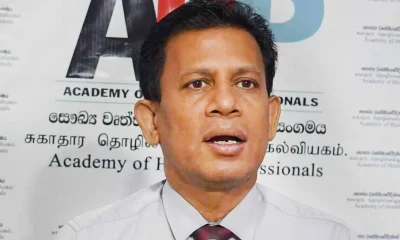
 News5 days ago
News5 days agoSuspension of Indian drug part of cover-up by NMRA: Academy of Health Professionals
-

 Opinion6 days ago
Opinion6 days agoRanwala crash: Govt. lays bare its true face
-

 News6 days ago
News6 days agoCID probes unauthorised access to PNB’s vessel monitoring system


